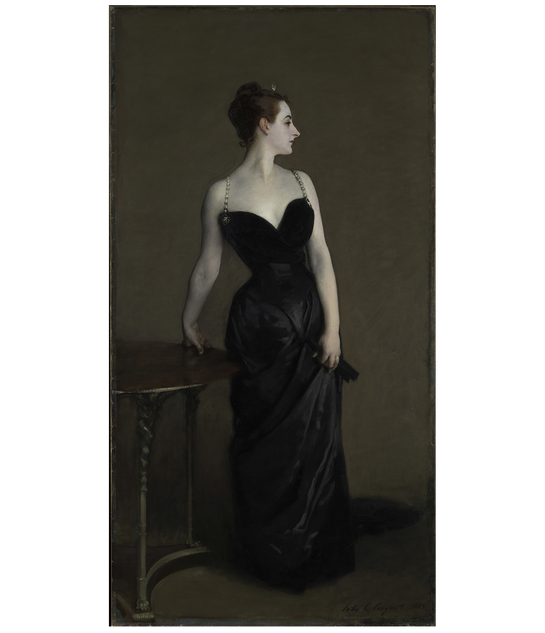In 1884, the crowded galleries of Paris’s annual Salon were filled with the usual sniping critics and society gossips. That year, however, the commentators had more than the usual to bicker over: on a canvas that would have stretched most of the way from the gallery’s ceiling to its floor, there was a figure that couldn’t escape gasps of upset propriety. One critic said that he couldn’t go 15 minutes without overhearing the accusation, “This woman is not wearing a shirt!”
The woman in question, painted by John Singer Sargent, was Virginie Amélie Avegno Gautreau, an American who had moved to France and married a banker twice her age. She had become a “professional beauty”, dressing in wonderful clothes and powdering her skin to make it paler. Gautreau—called Madame X in the title of Sargent’s portrait—was painted wearing a scandalously sexy sleeveless black dress with tight bodice and draped skirt. In the painting’s original version, one of the jewelled metallic straps had slipped off her shoulder, as if the whole dress could tumble to the floor and reveal her body beneath. After the barrage of negative responses, the young Sargent repainted the strap, diligently placing it back on Gautreau’s shoulder.
Madame X—in the UK for the first time in two decades—sits in the very first room of the Tate Britain’s spectacular new exhibition, Sargent and Fashion, which has recently travelled across the Atlantic from Boston’s Museum of Fine Arts. Its journey echoes that of its subject: Sargent, born in Florence to American parents, was always something of an expat in European culture; a Henry James-esque figure, or a character from one of his novels.
Sargent and Fashion takes the painter’s metier—portraits of society beauties in miles of silk; serious canvases of serious men—and places it in its context. These people were not painted in outrageously opulent outfits by accident; they chose them for their portraits (“Will it paint?” was the question asked by a certain section of society when buying a new frock). Their taffetas, silks and corseted shapes help to reveal the artist’s interest in and skill with fashion. He could imagine dresses in new shades—painting from his imagination, rather than life—or conjure outfits when models only had rolls of fabric to pose with. On one occasion, Sargent himself proclaimed that he was both “painter and dressmaker”, having altered the colour of his sitter’s dress to suit the portrait better.
After the coiled-spring sexiness of Madame X—Gautreau is taut and twisted in her pose, as if she, and the painting, are about to explode into the rest of the exhibition—the Tate’s rooms wind through the rest of Sargent’s career, from the white-frilled frothiness of Carnation, Lily, Lily, Rose (1885–6), through to scores of fashionable types painted across Europe, the UK and America, and finally into his more theatrical paintings. Here is the almost pre-Raphaelite drama of Ellen Terry as Lady Macbeth (1889) and the supreme loucheness of Dr Pozzi at Home (1881), a Parisian gynaecologist who was painted in his crimson dressing gown and Turkish slippers.
There is a material, fabric-y delight to this exhibition. Many of the sitters’ dresses are displayed alongside their portraits, making it possible to see how Sargent worked: altering the lines to make them more flattering, or bringing in new colours.
Sargent’s world was one of lavish haute-couture and costumed dress. In a painting of Robert Louis Stevenson and his wife, Frances, Sargent painted Frances draped in colourful South Asian clothing. There’s a sense of fun here, but it’s also more than that. Sargent painted—and dressed—his subjects as individuals. Focusing on their fashion—such as Ena Wertheimer’s crossdressing cavalier robes in one painting from 1904—is a way of revealing the sitter’s personality beyond the frame.
But is it facile, or somehow too obvious, to comment on fashion as a way of showing individuality? I don’t think so. Sargent clearly loved clothes, and the particular shapes they added to his paintings (even after it was out of fashion he made his models pose in a wide taffeta skirt). But, rather than being unified by its focus on couture, this exhibition is defined by its own variety. From prim pansies who look as though they belong in an Edith Wharton story to boldly androgynous Vernon Lee, Sargent used fashion as a way of telling a story—of playing with artifice and pinning it into new forms.
Sargent and Fashion is on display at Tate Britain until 7th July














